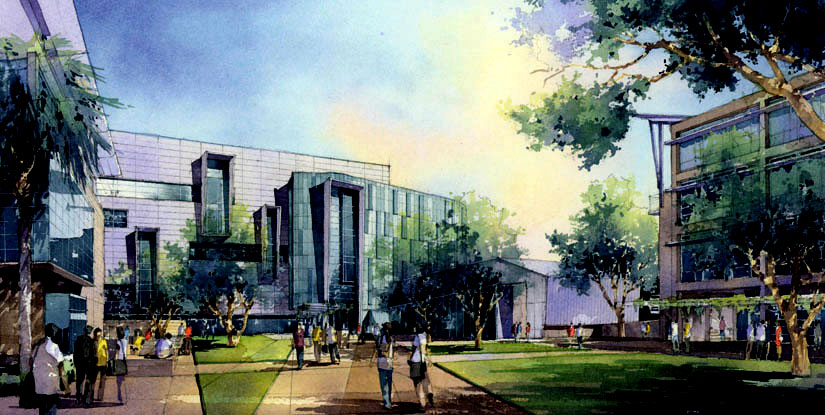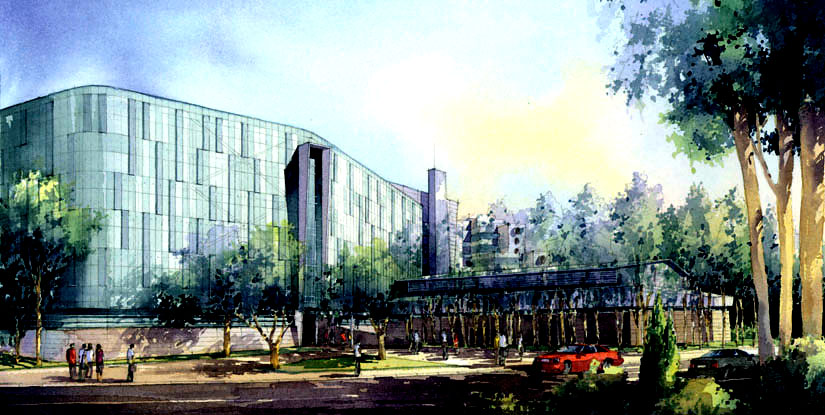Welcome to Brian's AE Senior Thesis e-Portfolio
Building Statistics
General Building Statistics
Building Name:
UCSD Cal IT2 Facilities and Design Building
Location and Site: University of California, San Diego,
CA College of Engineering
Building Occupant Name: UCSD Facilities Design and Construction
Occupancy or Function Types: Cal IT2 contains many research
labs for 3D scanning, processing, metrology, and laser research. Two new
features of the building are a 200 seat black box theater and a 2000 sq
ft exhibit gallery.
Size: 234,492 sq ft
Number of Stories:
Above Grade: 7 Stories
Total Levels: 8 Levels
Primary Project Team:
Owner: UCSD Facilities Design and Construction
Website: www.ucsd.edu
General Contractor: Gilbane
Website: www.gilbaneco.com
Architect: NBBJ Architects
Website: www.nbbj.com
Landscape Architect: Spurlock, Poirier
Website: www.sp-land.com
Civil Engineer: Pountney Consulting Group
Website: www.psomas.com
Structural Engineer: Rutherford & Chekene Consulting Engineering
Website: www.ruthchek.com
MEP Engineer: Flack & Kurtz Consulting Engineering
Website: www.flackandkurtz.com
Lighting Designer: HLB Lighting Design
Website: www.hlblighting.com
Dates of Construction (Start to Finish): Jan 2003 – Sept 2005
Cost: $61,200,000
Project Delivery Method: Design-Bid-Build
Architecture
The California Institute of Telecommunications and Information Technology at the University of California, San Diego makes a huge mark on technology in the campus. Through its architecture, it encourages the advancement of technology and expresses the use of wireless communication. The design of three different buildings integrated into one creates the sense of the different areas of research under one roof. The glass and steel box design emphasizes the importance of the ever-growing field in technology. Among the many spaces involved in this building, the Black-Box Theater space in section C creates an exciting space as you enter the darkened room with highlighted red chairs. It makes you anticipate something to happen in this dramatic space. The height of the building along with the elongated windows emphasizes the size of the building making it a staple in the academic courtyard. Another feature of this building is the underground tunnel or “wormhole” under the building to the other side. It serves as a passageway and shows the advancement of the changing campus and its acknowledgement for the convenience of the students and researchers.
Major National Model Codes
IBC 2000
NEC 2000
Title 24 – Energy Bill for California
Zoning and Historical
Higher Education Zoning
No major historical features
Building Envelope
As
one stares at the exterior of UCSD Cal IT2, one can see the design itself
showing through its architecture. On the North side facing the street, the
entire façade is tinted glass. Once you stare through it, the steel
design can be seen as a criss-cross pattern of HSS8 x 10 5/8 steel beams
and horizontal W21 x 68 steel beams for each floor. On the East, South and
West sides, a combination of resin wall panels, aluminum cladding for the
mullions, and various types of clear vision glass panels for the windows
spanning vertically and horizontally are used.
Construction
The project was constructed as a design-bid-build project. Design began in mid 2001 with the designers and owner at UCSD. Construction began as planned in January 2003 with a cost of roughly $54 million. UCSD Cal IT2 was planned to open in January 2005, but was delayed until September 2005. Construction costs grew to about $61.2 million averaging about $261/ sq ft with more square footage as originally planned.
Electrical
UCSD Cal IT2 uses both 480/277V and 208/120V standard power distributions for the 12kV provided by East campus. A 6-way switchboard is connected to distribute the power to three substations with one spare switch. A 750kW standby diesel generator is connected in case of a black-outage for elevators, emergency lighting, mechanical equipment, data back-up, and other necessities. From the substations, many power boards provide power to the three sections of Cal IT2 accordingly.
Lighting
UCSD Cal IT2 uses many different lighting systems through the building because of the various functions this building has. Most of the lighting is fed off the 277V power; however there are some fed off the 120V power. Because of Title 24 requirements in California, energy efficient lamps, controls and luminaries are used to decrease any power possible to the building. All open-office areas have automatic lighting shut-off, occupancy sensors are used for private offices and override the automatic shut-off, tandem wiring is used, and daylight area control is used for the larger open spaces where lighting may not be required during daylight hours. Emergency lighting is also in place throughout the building for evacuation and safety reasons. There are clearly labeled exit signs, power generators, and low wattage emergency spot lighting for black-outs, fires, etc.
On the exterior of the building, a variety of in-grade metal halide up-lights, compact fluorescent step lights, metal halide PAR flood lights, HID sconces, low pressure sodium pole lights, and compact fluorescent bollards are used to highlight the building and walkways to the building for safety purposes and aesthetics.
For
the interior, the amount of light fixtures used is immense. In the East
Lobby and many surrounding corridors, large decorative compact fluorescent
pendants are hung from the ceiling emphasizing the height of the space.
The North Lobby uses blue cove lights surrounding the cove ceiling with
compact fluorescent downlights for ambient lighting. More fluorescent wall-washers
are used throughout the building on corridors and decorative colored walls.
Suspended fluorescent T8 fixtures are used for open office areas along with
recessed strip lights in private offices and some corridors. As can be seen,
because of the variety of spaces for this building, the lighting was designed
to coordinate with each separate space while also integrating each space
into the next with similar lamps, feels, and ambience.
Mechanical
UCSD Cal IT2 utilizes 16 air handling units (AHU). The clean room has its own AHU with a 16,000 cfm supply and 11 AHU for re-circulation. It contains a hydronic cooling coil, heating coil, and a preheating coil fueled by an oil storage tank with a leak monitoring system. The two big AHU located on the roof of section B are supplying air at 86,000 cfm to the 7 floors below. All systems are using a VAV system with air-recirculation in emphasis for the clean room.
Structural
A steel structural system is used for UCSD Cal IT2. The beams support 16 and 18 gauge metal decking with a concrete slab per floor. The steel columns surrounding the building vary in size and support the building from wind load. Trusses support the metal decking and loads for the upper floors in Section B. Along the North side, the steel bracing creates a truss pattern with W21 x 68 girders. Because of the location, the building was built with seismic connections and standards.
Fire Protection
Fire protection is an important issue within higher education buildings. All primary steel members are sprayed with a 3 hour rating while secondary members are sprayed with 2 hour ratings. As for fire warning systems, the whole building is equipped with hand-pull fire stations, fire extinguishers, horns, smoke/heat detectors, and strobes. A sprinkler system, compatible with UCSD fire marshal standards, is installed throughout the building.
Plumbing
UCSD Cal IT2 uses 2 oil powered double wall water heaters from manufacturer P-K Compact Series with a domestic flow rate of 44 gpm. The thermal expansion tank has a capacity of 77 gallons. The oil tank underground is leak monitored by a panel underground as well. Pumps are used to get the water from the mechanical room to the upper floors. Emergency power is supplied to the pumps for safety showers in the labs and the sprinkler system. Seismic restraints are also in place in case of earthquake activity.
Transportation
Cal IT2 houses four passenger elevators located in sections B and C for transportation to the above floors with only one going to the penthouse on level 7. Elevators #1, #2, and #3 are all traction type elevators. Elevators #1 and #2 have capacities of 3500 lbs and move at a speed of 350 ft per minute while elevator #3 (to the Penthouse) has a capacity of 4000 lbs moving at the same speed. Elevator #4 is located in section C outside the Black-Box Theater. It is a hydraulic type elevator with a capacity of 2500 lbs and moves at a speed of 125 ft per minute. Emergency power is provided to these elevators during a black-out.
Telecommunications
Every space in the UCSD Cal IT2 building is equipped with basic voice and data jacks as well as wireless communication in many spaces. Being a state of the art technological building with laboratories, research facilities and offices, it is expected that the building be as equipped as it actually is.
Special Systems
UCSD Cal IT2 uses a P-2000 card swipe access security precautions for students and researchers entering the building.


